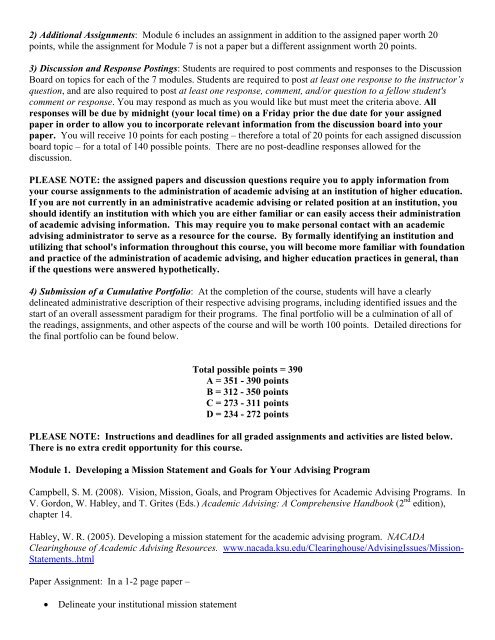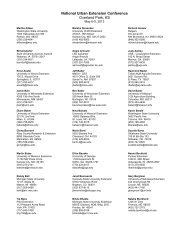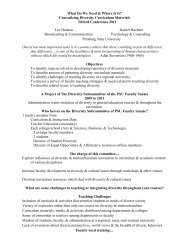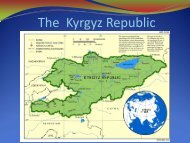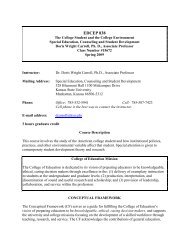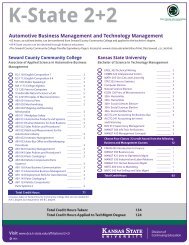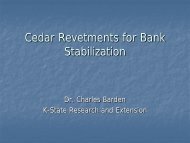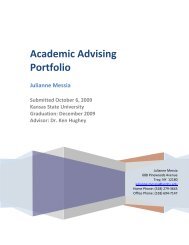Syllabus Sample - Kansas State University
Syllabus Sample - Kansas State University
Syllabus Sample - Kansas State University
Create successful ePaper yourself
Turn your PDF publications into a flip-book with our unique Google optimized e-Paper software.
2) Additional Assignments: Module 6 includes an assignment in addition to the assigned paper worth 20<br />
points, while the assignment for Module 7 is not a paper but a different assignment worth 20 points.<br />
3) Discussion and Response Postings: Students are required to post comments and responses to the Discussion<br />
Board on topics for each of the 7 modules. Students are required to post at least one response to the instructor’s<br />
question, and are also required to post at least one response, comment, and/or question to a fellow student's<br />
comment or response. You may respond as much as you would like but must meet the criteria above. All<br />
responses will be due by midnight (your local time) on a Friday prior the due date for your assigned<br />
paper in order to allow you to incorporate relevant information from the discussion board into your<br />
paper. You will receive 10 points for each posting – therefore a total of 20 points for each assigned discussion<br />
board topic – for a total of 140 possible points. There are no post-deadline responses allowed for the<br />
discussion.<br />
PLEASE NOTE: the assigned papers and discussion questions require you to apply information from<br />
your course assignments to the administration of academic advising at an institution of higher education.<br />
If you are not currently in an administrative academic advising or related position at an institution, you<br />
should identify an institution with which you are either familiar or can easily access their administration<br />
of academic advising information. This may require you to make personal contact with an academic<br />
advising administrator to serve as a resource for the course. By formally identifying an institution and<br />
utilizing that school's information throughout this course, you will become more familiar with foundation<br />
and practice of the administration of academic advising, and higher education practices in general, than<br />
if the questions were answered hypothetically.<br />
4) Submission of a Cumulative Portfolio: At the completion of the course, students will have a clearly<br />
delineated administrative description of their respective advising programs, including identified issues and the<br />
start of an overall assessment paradigm for their programs. The final portfolio will be a culmination of all of<br />
the readings, assignments, and other aspects of the course and will be worth 100 points. Detailed directions for<br />
the final portfolio can be found below.<br />
Total possible points = 390<br />
A = 351 - 390 points<br />
B = 312 - 350 points<br />
C = 273 - 311 points<br />
D = 234 - 272 points<br />
PLEASE NOTE: Instructions and deadlines for all graded assignments and activities are listed below.<br />
There is no extra credit opportunity for this course.<br />
Module 1. Developing a Mission <strong>State</strong>ment and Goals for Your Advising Program<br />
Campbell, S. M. (2008). Vision, Mission, Goals, and Program Objectives for Academic Advising Programs. In<br />
V. Gordon, W. Habley, and T. Grites (Eds.) Academic Advising: A Comprehensive Handbook (2 nd edition),<br />
chapter 14.<br />
Habley, W. R. (2005). Developing a mission statement for the academic advising program. NACADA<br />
Clearinghouse of Academic Advising Resources. www.nacada.ksu.edu/Clearinghouse/AdvisingIssues/Mission-<br />
<strong>State</strong>ments..html<br />
Paper Assignment: In a 1-2 page paper –<br />
• Delineate your institutional mission statement


